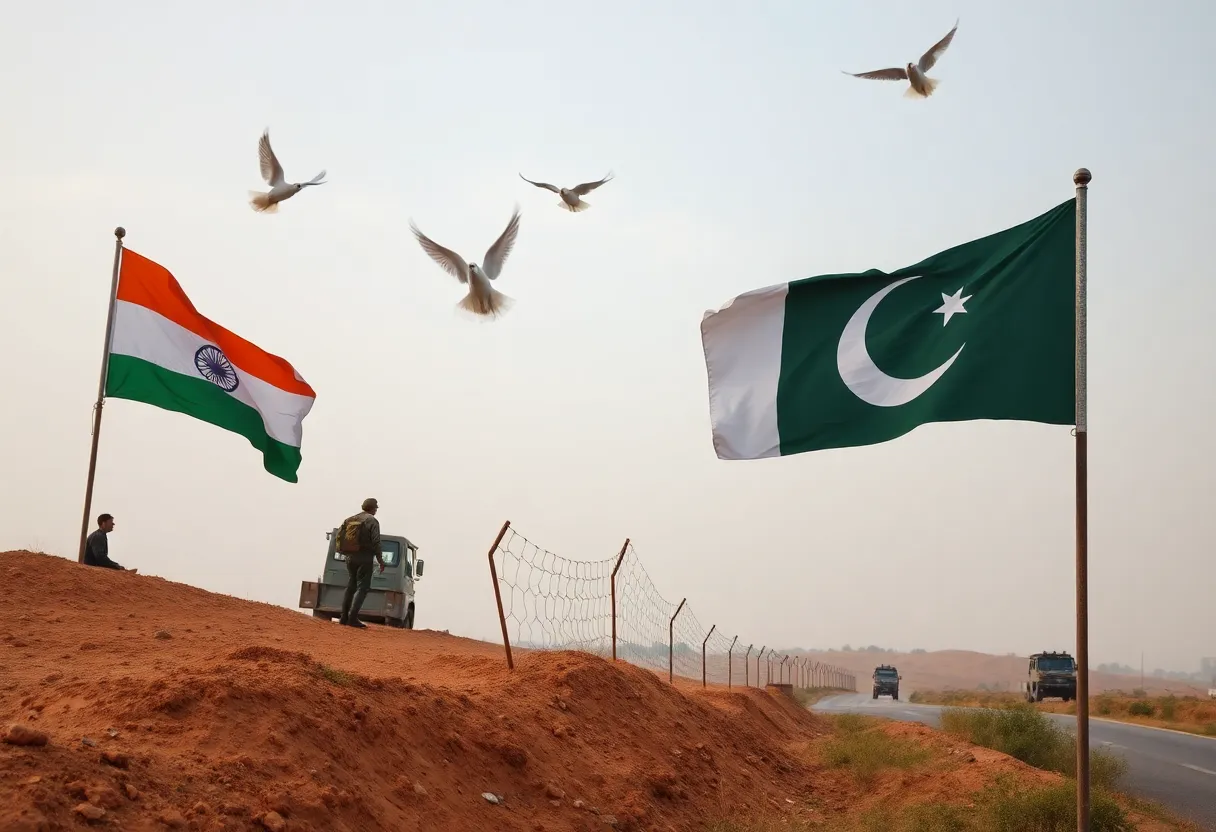News Summary
In a dramatic turn, India and Pakistan have declared a full ceasefire to halt ongoing clashes. The announcement follows tensions that built up over recent military strikes and marks a potential step toward peace, with the U.S. reportedly mediating discussions. However, sporadic violence still continues, raising concerns about the sustainability of the ceasefire. Both nations have expressed their willingness for dialogue, but the delicate situation remains closely monitored by the international community.
Ceasefire Announced Between India and Pakistan Amid Tensions
In a surprising yet hopeful turn of events, India and Pakistan have agreed to a full and immediate ceasefire, aiming to put an end to their recent clashes, which have been the most intense the countries have seen in decades. The announcement was made early Saturday, just after 8 a.m. ET, bringing a glimmer of hope to a region long plagued by conflict.
A Night of Negotiations
The announcement came from an unexpected source when US President Donald Trump took to his social media platform, claiming that the ceasefire was the result of a long night of talks mediated by the United States. Not only did he commend both countries for their willingness to cooperate, but he also hinted at future discussions covering a broad array of issues to be held at a neutral location.
Immediate Reactions
Within minutes of the ceasefire being announced, both nations quickly confirmed their agreement. The Pakistani government expressed gratitude toward the US for its role, referring to the leadership shown in paving the way for peace. Meanwhile, India played down the significance of US involvement, stating that the agreement was primarily reached directly between the two countries.
A History of Tension
The backdrop of this ceasefire is a troubling history of conflict between India and Pakistan, focusing predominantly on the disputed region of Kashmir. Their rivalry has led to numerous skirmishes, including two major wars since their independence in 1947. Past negotiations have often been marred by skepticism, especially regarding foreign mediation.
Escalation Before the Ceasefire
Just days before the ceasefire announcement, tensions were at a boiling point, with multi-day military strikes carried out across both territories. Reports indicated that India had targeted multiple Pakistani military bases, prompting Pakistan to retaliate with its military response, citing an “eye for an eye” policy. The severity of these military actions led to tragic losses on both sides, with India reporting civilian casualties from Pakistani shelling and Pakistan citing deaths due to Indian attacks.
Reports of Continued Conflict
Impact and Future Considerations
The conflict had seen brutal escalations, particularly spurred by a recent tragic attack in Pahalgam, resulting in significant casualties for India. This prompted military responses that amplified the existing tensions dramatically. As both sides experienced casualties, the need for a peaceful resolution became all the more urgent, with the international community voicing concerns about the potential for further escalations.
International Response
Conclusion
While this ceasefire has given rise to optimism, the situation remains fragile. With both nations accused of ongoing military actions even after the agreement, many are left wondering whether this halt in fighting can result in a meaningful and lasting peace. It’s a delicate situation, and all eyes will be on India and Pakistan in the days to come as they navigate this challenging terrain.
Deeper Dive: News & Info About This Topic
- CNN: India-Pakistan Ceasefire Explainer
- Wikipedia: India–Pakistan Relations
- Al Jazeera: India-Pakistan Live Updates
- Google Search: India Pakistan ceasefire
- NDTV: Trump’s Mediation Offer
- Encyclopedia Britannica: Kashmir Conflict
- The Guardian: Pakistan Air Bases Attack Updates
- Google News: India Pakistan conflict

Author: STAFF HERE AUGUSTA WRITER
The AUGUSTA STAFF WRITER represents the experienced team at HEREAugusta.com, your go-to source for actionable local news and information in Augusta, Richmond County, and beyond. Specializing in "news you can use," we cover essential topics like product reviews for personal and business needs, local business directories, politics, real estate trends, neighborhood insights, and state news affecting the area—with deep expertise drawn from years of dedicated reporting and strong community input, including local press releases and business updates. We deliver top reporting on high-value events such as Arts in the Heart Festival, Westobou Festival, and Masters Week. Our coverage extends to key organizations like the Augusta Metro Chamber of Commerce and Greater Augusta Arts Council, plus leading businesses in manufacturing and healthcare that power the local economy such as Textron Specialized Vehicles, Cardinal Health, and Nutrien. As part of the broader HERE network, including HEREAtlanta.com and HERESavannah.com, we provide comprehensive, credible insights into Georgia's dynamic landscape.





